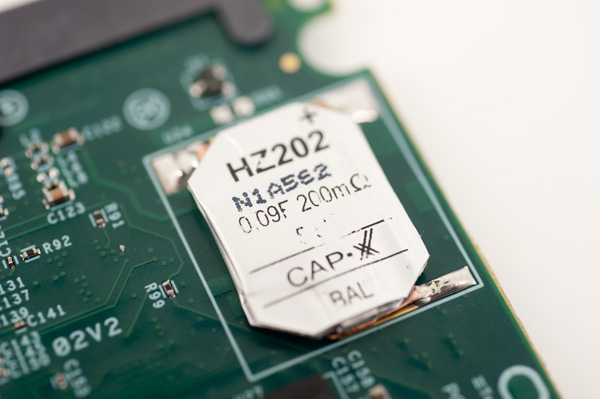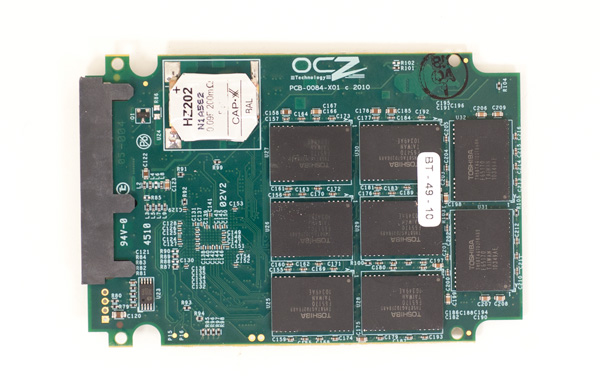OCZ Vertex 3 Pro Preview: The First SF-2500 SSD
by Anand Lal Shimpi on February 17, 2011 3:01 AM ESTToday: Toshiba 32nm Toggle NAND, Tomorrow: IMFT 25nm
The Vertex 3 Pro sample I received is a drive rated at 200GB with 256GB of NAND on-board. The SF-2682 controller is still an 8-channel architecture and OCZ populates all 8 channels with a total of 16 NAND devices. OCZ selected Toshiba 32nm Toggle Mode MLC NAND for these early Vertex 3 Pro samples however final shipping versions might transition to IMFT 25nm. The consumer version (Vertex 3) will use IMFT 25nm for sure.
Each of the 16 NAND devices on board is 16GB in size. Each package is made up of four die (4GB a piece) and two planes per die (2GB per plane). Page sizes have changed. The older 34nm Intel NAND used a 4KB page size and a 1MB block size. For Toshiba's 32nm Toggle NAND pages are now 8KB and block size remains unchanged. The move to 25nm will finally double block size as well.
Remember from our earlier description of SandForce's architecture that its data redundancy requires a single die's worth of capacity. In this case 4GB of the 256GB of NAND is reserved for data parity and the remaining 66GB is used for block replacement (either cleaning or bad block replacement). The 200GB drive has a 186GB formatted capacity in Windows.
This is a drive with an enterprise focus so the 27.2% spare area is not unusual. You can expect the consumer versions to set aside less spare area, likely at little impact to performance.

The 0.09F supercap, a feature of the enterprise level SF-2500 controller. This won't be present on the client Vertex 3.
The Vertex 3 Pro is still at least a month or two away from shipping so pricing could change, but right now OCZ is estimating sales at between $3.75 and $5.25 per GB. The client focused Vertex 3 will be significantly cheaper - I'd estimate somewhere north (but within range) of what you can currently buy Vertex 2 drives for.
| OCZ Vertex 3 Pro Pricing | |||||
| 100GB | 200GB | 400GB | |||
| MSRP | $525.00 | $775.00 | $1350.00 | ||
| Cost per GB | $5.35/GB | $3.875/GB | $3.375/GB | ||
Both the Vertex 3 and Vertex 3 Pro are expected to be available as early as March, however as always I'd be cautious in jumping on a brand new controller with brand new firmware without giving both some time to mature.












144 Comments
View All Comments
bigboxes - Thursday, February 17, 2011 - link
Anand, I know you mentioned read/write and having your data a year after your last write. Does the future of SSD going to allow long-term storage on these devices? Will our data last longer than a year in storage or in use as read-only? I figured when cost went down and capacity went up that we'd start seeing SSD's truly replace HDD as the medium of long-term storage. Any insights into the (near) future?marraco - Thursday, February 17, 2011 - link
We need a roundup of SATA 6Gb controllers on AMD and Intel.How do added cards perform against integrated SATA 6Gb?
jwilliams4200 - Thursday, February 17, 2011 - link
Here are the numbers given in the AS-SSD incompressible write speed chart forSF-2500 (clean, dirty, after TRIM):
229.5 MB/s 230.0 MB/s 198.2 MB/s
Logically, I would expect the dirty number to be less than or equal to the after-TRIM number. Is there a typo here?
jwilliams4200 - Thursday, February 17, 2011 - link
Anand:Could you run the data files for your 2011 storage bench (heavy and light cases) through a couple of standard compression programs and report the compressed and uncompressed file sizes? That would be useful information to know when evaluating the performance of Sandforce SSDs on your storage benchmark.
Chloiber - Thursday, February 17, 2011 - link
Indeed, this would be an important piece of information.mstone29 - Thursday, February 17, 2011 - link
It's been out for a few weeks and the performance is on par w/ the OCZ V3.Does OCZ pay better?
Anand Lal Shimpi - Sunday, February 20, 2011 - link
We're still waiting for our Corsair P3 sample, as soon as we get it you'll see a review :)Take care,
Anand
gotFrosty - Thursday, February 17, 2011 - link
I personally will never buy from OCZ ever again... The way that they are treating the customers (including me) with this shady marketing scandal. Never will I deal with them. Never. Who is to say that they will not pull this crap somewhere down the line again.They changed the way they manufactured the drives. Ok thats well and fine, but at least change the product number/name whatever so that end users can distinguish between the products. Right now I'm sitting with a drive that they can't tell me whether its the slower 25nm or the 34. What kind of crap is that. I can't tell either because my build is waiting on the P67's to get fixed. Oh and to still market the drive as the same Vertex 2 that got all the great reviews.
Lets just say I'm a little irritated with the whole scheme. I feel robbed.
Mr Perfect - Friday, February 18, 2011 - link
Just stumbled across the whole Vertex 2 issue myself. Link to an explanation of what Frosty is mad about below:http://www.storagereview.com/ocz_issues_mea_culpa_...
I'm not impressed with OCZ right now. Anand, any way you could talk to OCZ about this issue?
db808 - Thursday, February 17, 2011 - link
Hi Anand,Thanks for another great SSD article. I own a OCZ Vertex 2 for my personal use, and I have been doing some testing of SSDs for work use.
I have a questions/comments that will probably stir up some additional discussion.
1) You present a good description on your personal workload write volume at 7GB / day, and how that even with that heavy amount of activity, the SSD life expectancy is much greater than the warranty period.
Did you ever try to correlate this with the life expectancy (or read and write activity) reported by the SSD using the SMART attributes?
In my first 3 weeks using a new Vertex 2 SSD as my boot disk, I averaged over 18 GB/day of write activity ... much greater than your reported 7 GB/day.
I can not say for other Sandforce implementations, but the OCZ Vertex 2 does report a wide variety of useful statistics via the vendor-specific SMART statistics. These statistics can be displayed using the OCZ Toolbox:
http://www.ocztechnologyforum.com/forum/showthread...
I don't know if other SSD vendors have similar information. Crystal Disk Info (http://crystalmark.info/software/CrystalDiskInfo/i... also displays and formats many of the vendor-specific fields, but I don't know if it specifically displays the extended info for specific SSDs.
Using the OCZ Toolbox (which works with all OCZ Sandforce SSDs), you can display a lot of interesting information. Here is the statistics for the first 3 weeks of usage from my SSD. No real benchmarking, just doing the initial install of Windows 7 64-bit, and then installing all the apps that I run. My 120 GB SSD is about half full, including a 8 gb page and 8 gb hiberbate file. I also relocated my Windows search index off the SSD. Temp IS on the SSD (my choice).
SMART READ DATA
Revision: 10
Attributes List
1: SSD Raw Read Error Rate Normalized Rate: 100 total ECC and RAISE errors
5: SSD Retired Block Count Reserve blocks remaining: 100%
9: SSD Power-On Hours Total hours power on: 351
12: SSD Power Cycle Count Count of power on/off cycles: 84
171: SSD Program Fail Count Total number of Flash program operation failures: 0
172: SSD Erase Fail Count Total number of Flash erase operation failures: 0
174: SSD Unexpected power loss count Total number of unexpected power loss: 19
177: SSD Wear Range Delta Delta between most-worn and least-worn Flash blocks: 0
181: SSD Program Fail Count Total number of Flash program operation failures: 0
182: SSD Erase Fail Count Total number of Flash erase operation failures: 0
187: SSD Reported Uncorrectable Errors Uncorrectable RAISE errors reported to the host for all data access: 0
194: SSD Temperature Monitoring Current: 1 High: 129 Low: 127
195: SSD ECC On-the-fly Count Normalized Rate: 100
196: SSD Reallocation Event Count Total number of reallocated Flash blocks: 0
231: SSD Life Left Approximate SDD life Remaining: 100%
241: SSD Lifetime writes from host Number of bytes written to SSD: 384 GB
242: SSD Lifetime reads from host Number of bytes read from SSD: 832 GB
For my first 3 weeks, using the PC primarily after work and on weekends, I averaged 18.2 GB/day of write activity ... or 384 GB total.
You may want to re-assess the classification of your 7 GB/day workload as "heavy". I don't think my 18.2 GB/day workload was extra heavy. My system has 8 GB of memory, and typically runs between 2-3 gb used, so I don't believe that there is a lot of activity to the page file. I have a hibernate file because I use a UPS, and it allows me to "resume" after a power blip vs. a full shutdown.
Well ... back to the point .... The OCZ toolbox reports an estimated remaining life expectancy. I have not run my SSD long enough to register a 1% usage yet, but I will be looking at what volume of total write activity finally triggers the disk to report only 99% remaining life.
I don't know if the OCZ Toolbox SMART reporting will work with non-OCZ Sandforce-based SSDs.
If you can get a life expectancy value from your Sandforce SSDs, it would be interesting to see how it correlates with your synthetic estimates.
Thanks again for a great article!